Menu
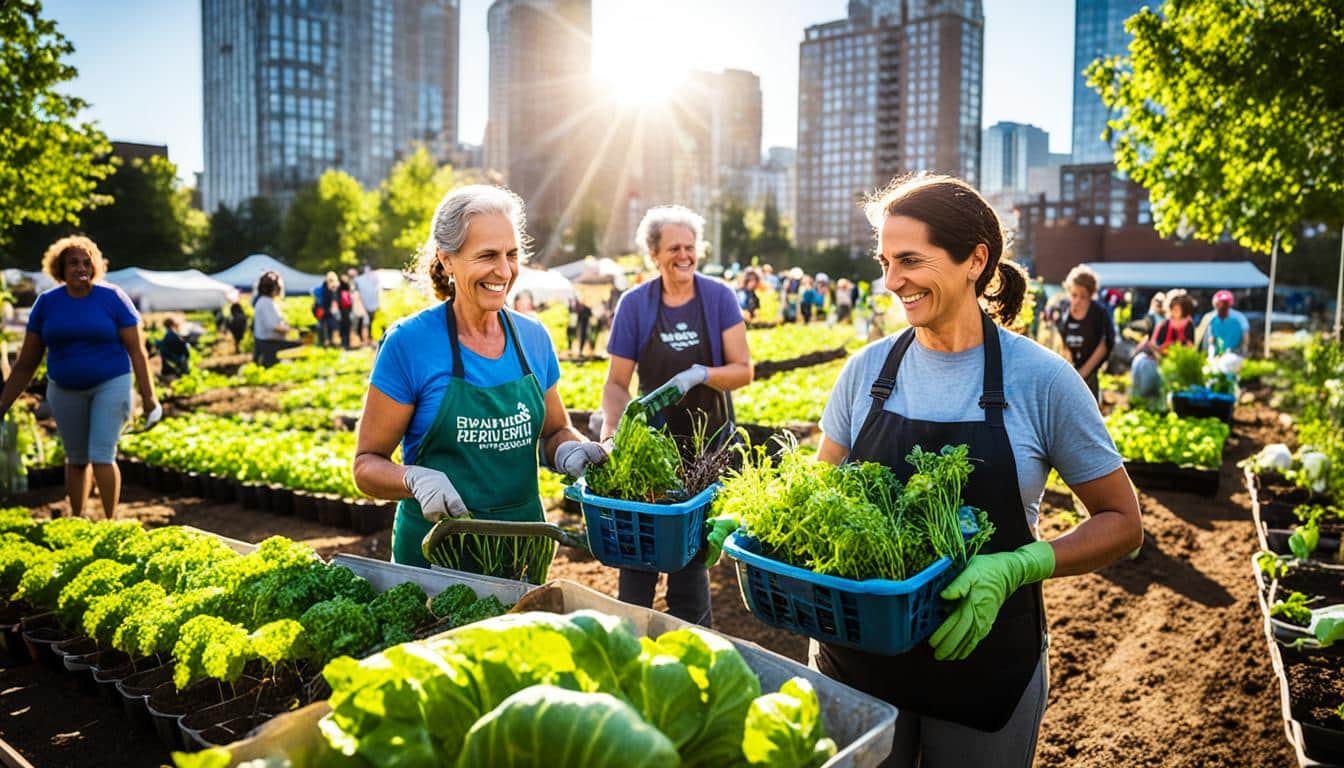
Did you know that 75% of new farmers starting at places like Urban Edge Farm say having affordable land is crucial? This big number shows how important it is to work together in urban farming. Now, more than ever, cities are becoming places where food is grown, not just eaten, thanks to a rising focus on environmental issues.
Urban farming is about growing, processing, and sharing food in and around cities. This way of farming has become very popular because more people care about the planet. By working with local groups, we can make our neighbourhoods healthier. It’s all about meeting what people want and need. When we work on urban farming together, we offer everyone better food choices. This also means we take care of our planet and value different points of view.
The urban farming movement is changing our cities by growing food in them. It includes community gardens, farms on roofs, and growing food up high. All these urban farming projects care about the environment and help their communities. They make sure there’s enough food and make people stronger against climate change.
Urban farming grows, makes, and shares food right where people live in cities. It uses places like empty lots and roofs to bring fresh food close to home. This way of farming is good for the earth and fits well with what communities need. It helps create a strong system for local food.
In Chicago, the Urban Agriculture program is leading in teaching about this kind of farming. It’s the only one in the area with a degree in growing food in cities. They have gardens and a big greenhouse, showing that urban farming can be successful with the right help and community support.
Working together is key to making urban farming work. By joining forces, urban farming groups can do more and overcome many problems. They focus on taking care of the environment and making sure everyone can get fresh food in the city. For example, students in Chicago help fight hunger by selling vegetables at markets and giving food to those in need.
Urban farming groups from all over the world, with help from many donors and investors, are working together. They support projects that help the planet and find new, smart ways to farm. Together, they encourage caring for the earth and growing food in water, like in hydroponic and aquaponic systems.
Working together in community gardens brings many benefits. They go beyond just growing food. They help bring people together, benefit both mind and body, and support local, sustainable food. By joining forces in gardening, communities create places that boost health and protect the environment. They also tackle the issue of food security.
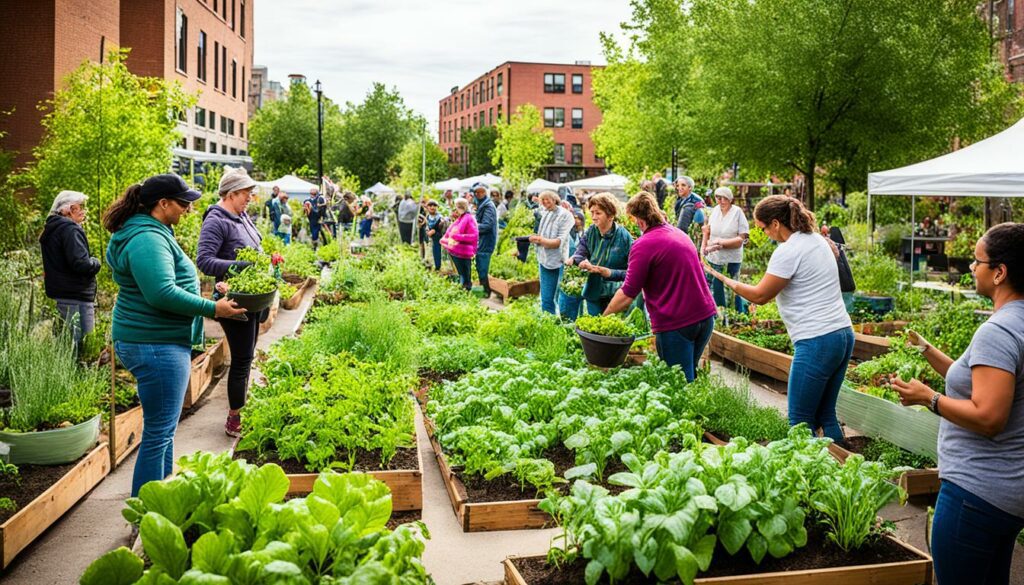
Community gardens are great for socialising. They help build strong connections within communities. Gardening is also great for your mind, often making you feel calm. Your body gets healthier from being outside more and eating freshly-grown foods. Overall, these gardens are key to a healthier, more sustainable way of getting food.
Looking at real examples shows us how community gardening works best. For example, the USDA’s People’s Garden Initiative started in 2009. It has 17 main gardens in Washington, D.C., and others in different areas. This project shows how gardens, even on government sites, can give away their food. It works with groups like food banks, schools, and conservationists, proving that various partners make projects stronger.
In 2020, the Urban Agriculture Resilience Program helped 80 projects across America. Its aim was to teach about growing food while helping with food shortages. Gardens in places like Alabama and Arizona, worked with groups like botanical gardens. By 2023, a lasting team was built, showing that ongoing teamwork boosts community projects.
| Year | Initiative | Key Collaborators |
|---|---|---|
| 2009 | People’s Garden Initiative | USDA Agencies, Food Banks, Girl Scouts |
| 2020 | Urban Agriculture Resilience Program | Citywide Botanical Gardens and Conservation Districts |
| 2021 | State Collaborations | Friends of Birmingham Botanical Gardens, Desert Botanical Garden, Queens Botanical Garden |
| 2023 | Capstone Cohort | Atlanta Botanical Garden, Pennsylvania Horticultural Society |
| 2024 | Expanded Collaborations | Georgeson Botanical Garden, Botanical Garden of the Ozarks |
These projects continue to grow, showing the powerful change community gardening can make. They transform urban areas to be more sustainable. Plus, they boost health and protect the environment.
City farming benefits a lot from teamwork, which makes it more sustainable. When people with different skills work together, they do tasks better and come up with new ideas. Everyone gains from working in a team, making the farming more able to change and grow.
In learning about city farming, working together is key. People bring their own experiences. This way, they find better ways to solve problems. With everyone’s help, making life sustainable doesn’t just sound good on paper. We can make it happen in real life, for a lot of people.
When teams focus on areas like planning events or finding land, farming in the city gets easier. Special groups can help the farm work better. This makes learning events more useful and better for everyone.
The market for vertical farming was $5.05 billion in 2023. It could reach $40.45 billion by 2032, expanding a lot. The hydroponics market was worth $17457.46 million in 2022. It might be $26321.93 million by 2028. These numbers show that by working together, people can do great things.
Good teamwork is behind many exciting city farming projects. These efforts show that farming in the city can be improved. Thanks to teamwork, not only are more foods grown locally, but less harmful gases harm our planet. This highlights the value of diverse skills and ideas in coming up with new ways for sustainable living.
| Urban Agriculture Career Roles | Entry-Level Requirements | Advanced Career Requirements |
|---|---|---|
| Horticulturists | Minimal advanced education, manual labour | Technical knowledge in horticulture |
| Agronomists | Minimal advanced education, manual labour | Technical knowledge in agronomy |
| Hydroponic Technicians | Minimal advanced education, manual labour | Technical knowledge in hydroponics |
| Management, Marketing, Community Outreach | Minimal advanced education, manual labour | Technical and managerial expertise |
Investors are a big part of making these teamwork-based projects happen. Their support makes farming in the city better and bigger. Everyone benefits from this, with more food security and new jobs.
The teamwork between city farmers, locals, and other groups is crucial for better local food. The USDA gave $7.4 million for 25 projects, showing a big support for city farming.
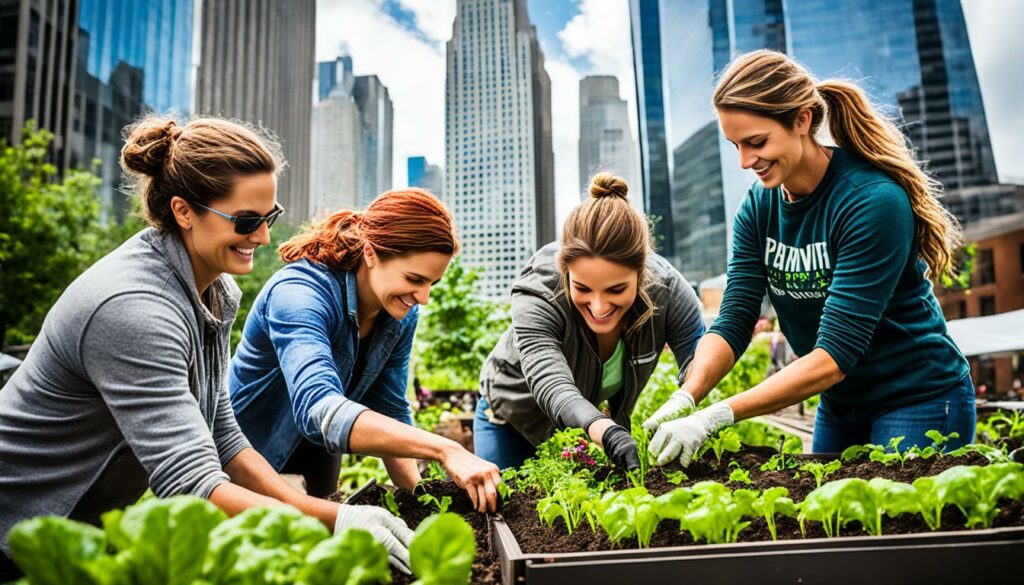
Working with the community is key. Many projects and events are happening, like in Washington D.C. They have a plan to grow more food by 2032, aiming for food security in the city.
These partnerships help cities grow their own food and need less from far away. I think working together on food helps make cities stronger. With city farming and everyone joining in, our food systems get better and last longer.
| Initiative | Funds Allocated | Objective |
|---|---|---|
| USDA Composting and Food Waste Reduction | $11.5 million | Reduction in food waste across 23 states |
| American Rescue Plan Funding | $550 million | Support for underserved producers and minority institutions |
| NIFA Urban Agriculture Research | $9.4 million | Advancing urban agricultural production research |
| USDA & Reinvestment Fund Partnership | $22.6 million | Increasing equitable access to healthy foods |
| Urban Hubs Support | Not Specified | Support for urban producers in select cities |
With projects and centers created, the USDA is pushing big changes in how we make food. This work strengthens the move towards stronger and lasting local food systems. Everyone coming together can make our food future better.
Urban agriculture partnerships help boost economic growth and make our food supplies stronger. They bring together local governments, businesses, and charities. They work to add more green areas to our cities and make sure there is enough food for everyone.
The USDA is a big supporter of these partnerships. They have put in over $11.5 million to help manage food waste better. This money went to 23 states. Plus, they spent $7.4 million on new ways to grow food in cities. The NIFA, which is part of the USDA, put $9.4 million into helping agriculture grow in new ways.
There’s also up to $550 million from the American Rescue Plan for projects that help farmers and schools with farming. The USDA and the Reinvestment Fund are working together to spend $22.6 million to make sure everyone can get healthy food.
| Investment Area | Amount |
|---|---|
| Composting and Food Waste Reduction | $11.5 million |
| Urban Agriculture and Innovative Production | $7.4 million |
| Research, Education, and Extension Initiatives | $9.4 million |
| American Rescue Plan Funding | Up to $550 million |
| Equitable Access to Healthy Foods | $22.6 million |
These partnerships don’t just bring new jobs but they also make communities stronger. Places like Albuquerque, Chicago, and Detroit have become urban agriculture hubs. Here, the USDA helps local farmers and new, creative ways of growing food. They offer support from saving the environment to dealing with bad luck with the weather.
The USDA also helps in other ways. They have new insurance for farmers using special indoor farms. They also give money and work with groups to improve growing food and getting it to people.
In the end, these partnerships help food supplies stay strong and make cities nicer to live in. By working together, these groups support farming in the city, making sure everyone has enough good food.
City agriculture alliances are key to a sustainable community. They bring together local governments, non-profits, and urban farmers. By working as a team, there’s a big boost in how urban farming helps with health, food, and the environment.
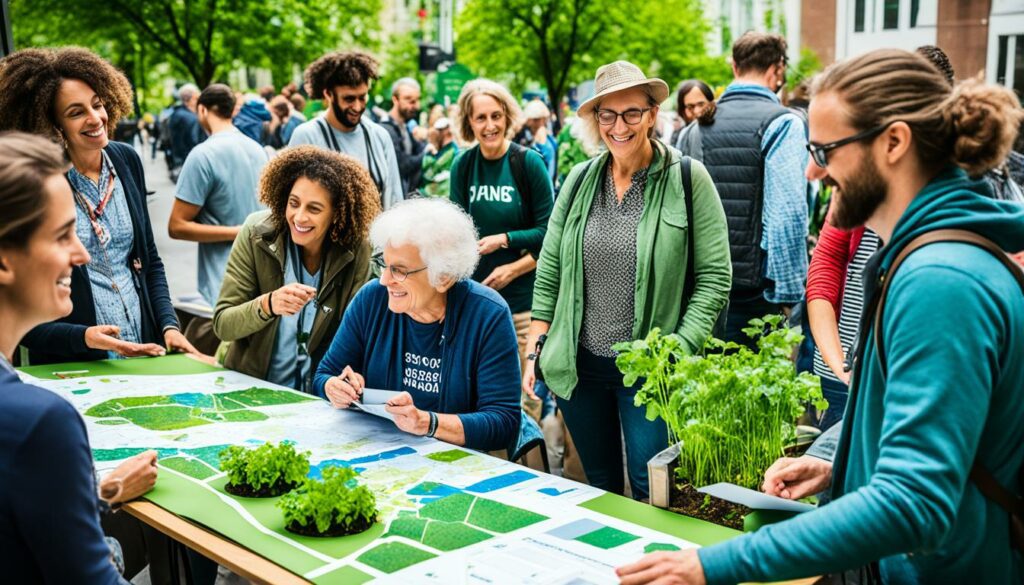
To create strong alliances, urban growers need to share goals and challenges. Take the Homegrown Minneapolis Food Council. They work to make local food better for health, the earth, and the economy. In New York City, the Mayor’s Office of Urban Agriculture leads efforts on climate-smart farming. Working together helps urban growers secure land for the long run.
Working across the city has big benefits. Places like Washington D.C. aim to grow 20 more acres of food by 2032. This shows how big urban farming can get. In Grand Rapids, they teach people about farming in cities. This includes composting and raising chickens. It helps make a community that’s informed and involved.
| City | Initiative | Goals |
|---|---|---|
| Washington D.C. | Office of Urban Agriculture | Cultivate 20 additional acres by 2032 |
| Grand Rapids, MI | Urban Agriculture Committee | Educate public on urban agriculture topics |
| Minneapolis, MN | Homegrown Minneapolis Food Council | Enhance health, protect the earth, boost economic vitality |
| New York City, NY | Mayor’s Office of Urban Agriculture | Develop climate-based agriculture strategies |
To sum up, city agriculture alliances help grow urban farming and secure lands. They improve access to fresh food and build a sustainable community. This work meets both short and long-term needs.
Working together in urban farming makes a big difference. It brings farmers, local businesses, and government together for a common cause. This helps build stronger communities in cities.
SiEUGreen stands out for its work in urban agriculture. They’ve worked in several places in Europe and China. In Aarhus, Denmark, they’ve helped over 300 local farmers in projects like Ø-haven, Denmark’s biggest community garden. These projects help locals access fresh food and support farming initiatives.
In Hatay, Turkey, the initiative has supported over 250 women to start farming in the city. These women set up small greenhouses in their gardens. It has helped boost their community both economically and socially. In Norway, a housing project is working towards a neighbourhood with no waste and emissions. It includes more than 1,000 homes.
San-Yuan farm in Beijing combines old and new farming methods. They let people rent small lands for farming. This makes people more connected to what they eat. It also reduces the need for food to travel long distances, which is good for the environment.
So, working together in city farming is a win-win. It helps individual farmers, organizations, and the community. This kind of effort supports greener and more sustainable cities.
Urban rooftop gardening partnerships play a key role in making our cities more sustainable. These projects help increase green spaces in urban areas. They also connect people to the environment around them.
Many different groups work together on these gardens. This includes government groups, non-profits, schools, and businesses. Their combined efforts make rooftop gardens more common in cities today.
Rooftop gardens help cities in lots of ways. They clean the air, cool down the city, and reduce rainwater flooding. These gardens also become homes for plants and insects, which is good for the city’s nature.
Support from the USDA helps these gardens grow. The USDA gives advice and money to help with rooftop gardening. They also fund projects that make gardens able to handle climate changes better.
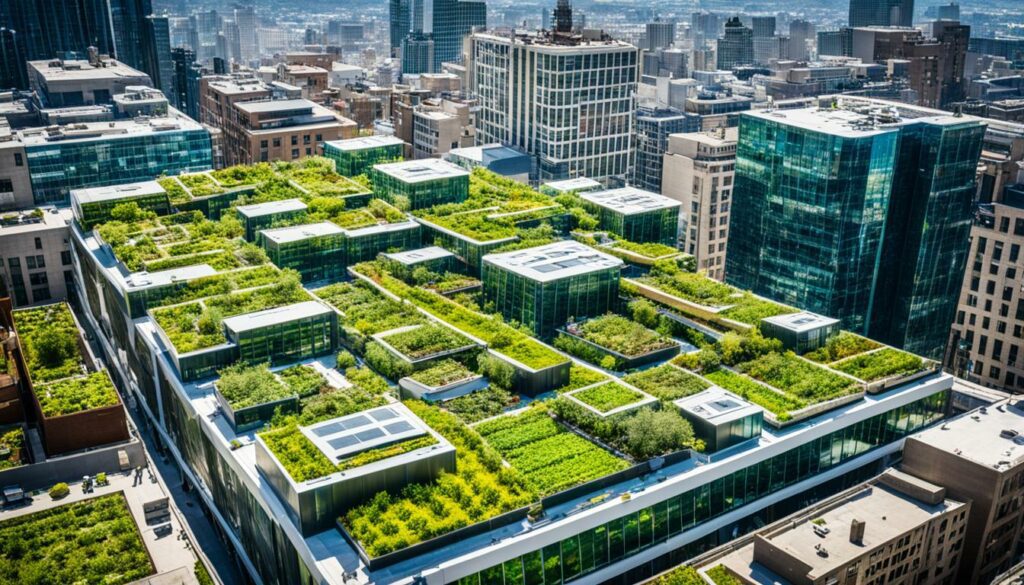
Success in rooftop gardening comes from many groups working together. For example, Brooklyn Grange in New York City has been very successful since 2010. It has five rooftop farms and provides jobs and food for the city.
Another great project is at Toronto Metropolitan University. They have two rooftop farms. These farms help study and improve the city’s nature.
Mill City Grows is another example. They made a garden on a roof using food waste from a local university. This garden helps save energy and gives food to local people.
| Organisation | Location | Year Established | Key Achievement |
|---|---|---|---|
| Brooklyn Grange | New York City | 2010 | 5 rooftop farms, 45 employees |
| Toronto Met University Urban Farming | Toronto | 2013, 2021 | 2 rooftop farms |
| Mill City Grows | Lowell, MA | 2013 | Experimental rooftop garden |
In closing, rooftop gardening partnerships make urban life better. They add green space and help cities run more smoothly. These gardens are good for the planet and engage many people. This ensures urban gardens can thrive in the long run.
Government support is key to successful urban farming in many cities. Local authorities create policies that make city areas more productive. They do this by supporting urban farming with grants, infrastructure, and training.
These urban farming policies help start new farms and keep them running for a long time. For instance, the U.S. Department of Agriculture (USDA) committed $14.2 million to 52 grants. This money supports urban and innovative production across 27 states.
Since the 2018 Farm Bill, the Urban Agriculture and Innovative Production (UAIP) program has funded many projects. It gave money to 18 planning and 34 implementation projects. This support helps urban farmers make the city more productive. It also provides job training and employment in the community.
The USDA has kept up its support, giving $26.3 million to projects since 2020. Public agriculture groups do more than provide financial help. They also help urban farmers reach more people and secure better deals, improving their business.
Government support is crucial for creating productive urban areas. They help with food security, build a sense of community, and promote taking care of the environment.
Non-profit organisations are key to urban farming. They help with money, know-how, and support, boosting local farming projects. These groups are the foundation for many community efforts.

In Kampala, Uganda, Camp Green teaches people how to farm in the city. They’ve helped over 10,000 folks since 2012. This has made food production more local and sustainable. In São Paulo, Ciades Sem Fome turns empty spaces into gardens to help people in need.
These non-profits bring communities together. For example, the City Farm Project in Bangkok has created a big farm for everyone. It grows food without harmful chemicals. Plus, they teach others how to do the same, making the whole community greener.
Let’s look at some important facts:
| Project | Location | Impact |
|---|---|---|
| Camp Green | Kampala, Uganda | Urban agriculture practices to over 10,000 residents |
| Ciades Sem Fome | São Paulo, Brazil | Transforming unused land into community gardens |
| City Farm Project | Bangkok, Thailand | Produces pesticide-free produce and offers workshops |
Back in 2015, mayors from 100+ cities signed the Milan Urban Food Policy Pact. This shows a worldwide push for better food systems. Milan is leading this with its Sustainable Food Project, a team effort by local government and non-profits.
Places like Whitelock Community Farm in Baltimore provide fresh food and jobs. Then, there’s the Gaza Project, boosted by Oxfam Italy and RUAF. They’re working on better farming practices and policies to help more people.
Universities are also stepping up. At Tulane, students learn not just in class but with hands-on urban farming projects. These lessons inspire a new generation of farmers, promoting farming in cities for years to come.
Non-profits are vital in making urban farming work. With cities growing, their efforts are more important than ever for healthier and sustainable places to live.
Educational places are key partners in urban farming. They help directly and by teaching students. Their role is crucial in turning what’s learned in class into real projects.
Farms backed by universities are leading in new ideas and hands-on learning. They teach students how to farm sustainably. This prepares them well for the challenges ahead.
Many schools are now part of this approach. The USDA’s latest funds of about $43 million show a big interest in urban farming. This money is important for projects in schools to keep growing.
Teaching programs about urban farming are crucial for rich farming studies. They cover topics like sustainable farming and protecting the environment. Including these topics makes urban farming education better.
The NIFA’s $9.4 million for education in agriculture also plays a big role. It helps schools give a full training, from basics to real practice. This way, students get a solid view of urban farming.
Also, school efforts go outside classrooms. For instance, the USDA giving $22.6 million with the Reinvestment Fund is for the community too. It focuses on making healthy food available to all. Such actions really help in changing urban food systems and making communities stronger.
So, the link between schools and urban farming is very important. By helping local farms and teaching about farming in cities, schools are building a better future. They aim for both farming and public health to improve.
“Education is the most powerful weapon which you can use to change the world.” – Nelson Mandela
| Funding Initiative | Amount Invested | Focus Area | Year |
|---|---|---|---|
| Composting and Food Waste Reduction Projects | $11.5 million | Waste Reduction | 2024 |
| Urban Agriculture and Innovative Production | $7.4 million | Urban Farming | 2023 |
| Emerging Agricultural Production Initiative | $9.4 million | Educational Programmes | 2023 |
| Urban Agriculture and Innovative Production | $14.2 million | Urban Farming | 2022 |
| Equitable Healthy Food Access | $22.6 million | Food Access | 2022 |
The Newark Community Food System (NCFS) is a great example of how people working together can change a city. It was set up to make Newark, New Jersey, a better place through farming. The NCFS has done well in facing the problems of getting food in cities.
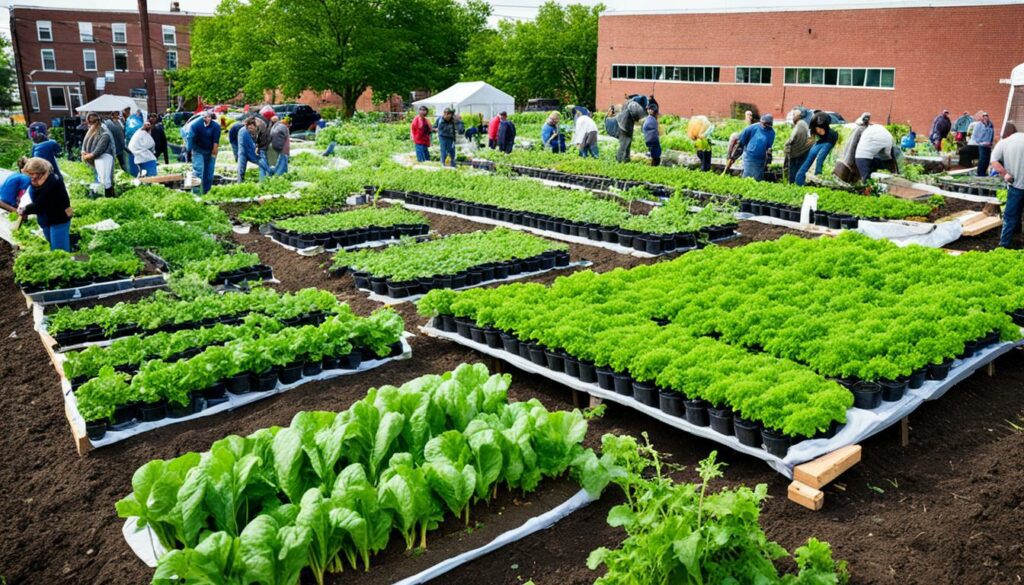
NCFS started to fix the lack of fresh food in Newark. Down Bottom Farms covers half an acre and includes a lot of fruit trees, berry patches, and a small vineyard. It all began with a course at Princeton University that wanted to solve food shortage issues. They also wanted to bring the community together. Princeton’s Environmental Institute helped build a storage shed at Down Bottom Farms. This showed how people from different places could come together to solve a problem.
To make urban farming work well, NCFS used some new ideas:
More and more, big cities are looking at urban farming. With most of the world living in cities by 2050, growing food in cities will be very important. The way we have been farming has caused damage to our planet. Bad weather has also made farming tough. Urban farming, like what NCFS does, offers a fresh look at how to feed our cities.
Places like the Newark Community Food System are very important for giving cities enough food. This matters a lot in places where it’s hard to find a shop selling fresh food. It’s beneficial because it cuts down on how much we travel to get our food. This, in turn, reduces the use of energy and materials in bringing food to us.
| Feature | Details |
|---|---|
| Plot Size | Half-acre |
| Key Features | Fruit tree orchard, berry patches, small vineyard |
| Mobile Storage | System built on wheels, can be split into two parts |
| University Involvement | Princeton Environmental Institute funding, interdisciplinary course |
| Core Focus Areas | Water resource management, energy efficiency, technology innovation, human and environmental health |
NCFS is dedicated to making urban farming a success. They stand out as a model for community teamwork and sustainable farming. Their efforts lead the way for other city projects on growing food.
The USDA is key in helping urban farming grow by giving important financial assistance and support. They help urban farmers all over the US to run successful farms. This means a lot of different USDA projects are making sure urban farms can do well.
An example is the big money put into composting and cutting down on food waste. The USDA has spent over $11.5 million in 23 states on these green projects. They hope to make city soils better and help cities grow more food in a natural way.
The USDA also helps through grants. They’ve put $7.4 million into 25 projects for new ways of farming. Alongside, $14.2 million went to another 52 projects. These grants let farmers use the latest methods to produce more food.
The National Institute of Food and Agriculture (NIFA) has a part by spending $9.4 million on various studies. These look into urban and indoor farming, plus new ways to grow food. This shows the USDA wants to help not just on farms but also with research and learning.
Another important aid comes from the Farm Loan Programs. With these, the USDA helps farmers get the money they need for land and equipment. This is key to let urban farming grow.
The USDA supports not just growing food but doing it in a way that cares for the Earth. The NRCS offers urban farming grants for eco-friendly practices. They help farmers use methods that help the planet.
The American Rescue Plan is also helping, with $550 million for special projects. These projects are for farmers who may not have had much help before. This money helps make sure everyone can be part of urban farming.
These efforts show how USDA is vital for urban farming to flourish. With their help, urban farmers are learning new ways to produce food. Their aid and investments keep USDA urban agriculture thriving across the country.
Urban agriculture funding is important for healthy city farming. Since 2020, UAIP grants have helped 186 projects with over $46.8 million. These projects bring together farmers, gardeners, officials, schools, and the people.
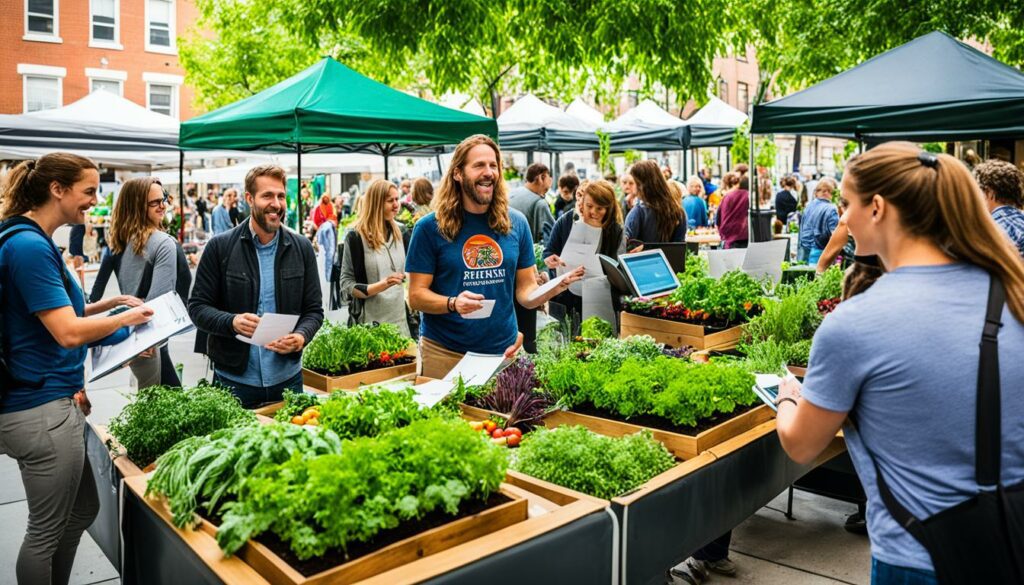
Lots of grant chances are open to many groups. Everyone from local to non-profit organisations can apply. For example, the New Castle Conservation District offers up to $3,000 for urban farming in Delaware. This helps make local food systems stronger and reduces waste.
The Brighter Future Fund gives up to $5,000. It focuses on helping BIPOC, women, and LGBTQIA+ farmers. These grants help diverse farmers thrive and have fair resources and chances.
The Urban Agriculture Resilience Program supports public gardens with grants from $5,000 to $20,000. It’s all about working together on urban agriculture. Nature’s Path has also helped 52 gardens with $515,000 through their grant program.
Education is key too. The White-Reinhardt Fund gives up to $1,000 for agricultural classes in schools. These help kids learn about good farming from a young age.
| Grant Program | Grant Amount | Purpose |
|---|---|---|
| New Castle Conservation District | Up to $3,000 | Urban farming and community garden projects |
| Brighter Future Fund | Up to $5,000 | Support for BIPOC, women, and LGBTQIA+ farmers |
| Urban Agriculture Resilience Program | $5,000 – $20,000 | Collaborative urban agriculture initiatives |
| Nature’s Path Gardens for Good | Over $515,000 total | Funding for community gardens |
| White-Reinhardt Fund for Education | Up to $1,000 | Agricultural literacy programs for grades K-12 |
These grants are vital for starting urban agriculture projects. They help reduce waste and add to community growth. With this funding, urban farming can grow stronger, more innovative, and sustainable.
Urban farming faces tough issues such as getting land, not having enough resources, dealing with zoning laws, and fighting bad weather. These urban farming challenges need smart and team efforts to make sure city farming can last and do well.
Finding money is a top problem. Yet, there are lots of investors around the world who want to help. These investors can pay for around half of the costs. This support is key for making long-lasting farming plans. With this cash, farms in cities can grow using green ways and keep going strong.
Farming in cities can team up with not just farming businesses but also with real estate, building, and making movies. This lets city farms learn from different fields and make a bigger mark. Online selling and marketing can help a lot too, paying for half the costs. This is a big help for overcoming tough challenges.
Looking beyond farming, there are groups that focus on using things over and over. They work together to do more good locally, like in tourism. These efforts are vital for making sure city farming can deal with problems and keep growing steadily.
Studies from the past show that groups joining hands do well in city farming. These include papers from FAO and journals like Agric. Hum. Values (2013) and Journal of Clean Production (2021). They make it clear that team work is essential for reaching goals in city farming sustainably.
Taking on circular economy ways is key, as seen in actions taken in Europe and beyond. Mixing with other groups helps city farms do better and stand strong against future issues.
To conclude, working together to face urban farming challenges with strong strategies makes urban farming hold up. It also opens the door for more advanced and lasting farming ways in cities.
In our look at urban farming, one thing is clear. Working together brings big wins for both the community and the Earth. Through teaming up, we’ve turned empty areas into full-of-life farmlands. This brings fresh food closer to city dwellers. Plus, we’re using high-tech methods to do this better, saving resources and getting more crops.
By combining our resources and smarts, we’ve solved many farming issues. This includes getting food to people, selling it well, and dealing with tech problems. The trend towards community efforts is making urban farms stronger and bringing people closer. These partnerships make sure city farming is tough, open to all, and meets many needs.
As we move ahead, sharing what we know and working together are key. Teaching others about green farming and getting them involved can really change how we eat and choose things. With teamwork, urban farming can do even more good. It can help the planet, cut down pollution, and keep our food supply steady in cities everywhere.
Urban farming is growing, making, and sharing food in towns and cities. It includes things like community gardens and farms on rooftops. This helps get food closer to where people live.
Joining forces in urban farming brings together skills and knowledge. It makes things more efficient. This teamwork is great for the planet, helps everyone have enough food, and makes communities stronger.
Community gardening is good for making friends and keeping fit. It also grows healthy food right in your neighbourhood. Plus, it brings more plants and animals to the area and makes people feel like they own a part of it.
Working together shares what we know and what we have. This makes the farming projects last longer and work better. It also means farmers can come up with new, smart ways to grow food.
By working together, people in the city can make more of their own food. They don’t have to rely on food from far away. This makes sure there’s enough good food in the city.
Partnerships in city farming help with jobs and make the community stronger against climate change. They also turn empty spaces into green places. This makes the food system better and able to manage different challenges.
Strong farming groups in the city focus on doing things the right way. They help farmers with things like finding land. These groups make sure there is enough fresh food and teach others too, which makes things better for everyone.
Working together, different groups in a community do their part to look after a farm. This might include farmers, shops, the council, and people living there. Everyone benefits from growing food and making the area nicer.
Partnerships that farm on rooftops help create a better town for plants and animals to live. They also make the city a better place to live. By working together, they can solve many problems and the city can grow more food.
The government helps turn parts of the city into farms. They offer money, teach people, and build things farmers need. This support makes farming in the city work well.
Non-profit groups give money, know-how, and fight for better conditions for farming. They work closely with the people making the food. This helps keep everyone healthy, look after the earth, and make local food.